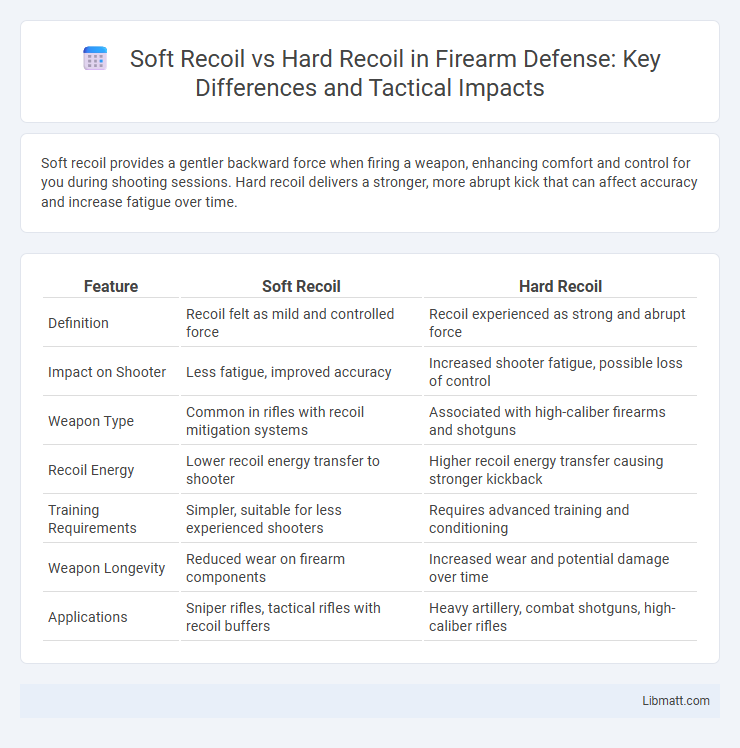Soft recoil provides a gentler backward force when firing a weapon, enhancing comfort and control for you during shooting sessions. Hard recoil delivers a stronger, more abrupt kick that can affect accuracy and increase fatigue over time.
Table of Comparison
| Feature | Soft Recoil | Hard Recoil |
|---|---|---|
| Definition | Recoil felt as mild and controlled force | Recoil experienced as strong and abrupt force |
| Impact on Shooter | Less fatigue, improved accuracy | Increased shooter fatigue, possible loss of control |
| Weapon Type | Common in rifles with recoil mitigation systems | Associated with high-caliber firearms and shotguns |
| Recoil Energy | Lower recoil energy transfer to shooter | Higher recoil energy transfer causing stronger kickback |
| Training Requirements | Simpler, suitable for less experienced shooters | Requires advanced training and conditioning |
| Weapon Longevity | Reduced wear on firearm components | Increased wear and potential damage over time |
| Applications | Sniper rifles, tactical rifles with recoil buffers | Heavy artillery, combat shotguns, high-caliber rifles |
Understanding Recoil: Hard vs Soft Defined
Understanding recoil involves distinguishing between hard recoil, which delivers a sharp, forceful kick felt strongly in the shoulder, and soft recoil, characterized by a gentler, more controlled backward motion. Hard recoil typically results from higher caliber firearms or heavier loads, producing greater impact and requiring more skill to manage effectively. Your shooting experience improves with weapons that have soft recoil, as they allow for faster follow-up shots and reduced shooter fatigue.
Physics Behind Recoil Forces
Soft recoil occurs when the recoil force is gradually absorbed and distributed over a longer time, resulting in less felt impact due to momentum transfer and energy dissipation. Hard recoil, characterized by a sudden and intense force, transmits energy rapidly to the shooter, causing sharper felt kickback linked to Newton's third law of motion. Understanding the physics behind recoil forces helps you optimize firearm control by managing kinetic energy transfer and impulse duration effectively.
Factors Influencing Recoil Experience
Recoil experience in firearms is influenced by factors such as firearm weight, caliber, ammunition type, and stock design. Softer recoil results from heavier firearms and lower caliber rounds, which distribute force more evenly, while harder recoil often accompanies lighter weapons and higher caliber ammunition that deliver sharper impulses to the shooter. Understanding these factors can help you choose the right firearm or ammunition to manage recoil effectively for improved shooting comfort and accuracy.
Soft Recoil: Mechanisms and Benefits
Soft recoil systems use spring buffers, gas pistons, or hydraulic dampers to absorb and reduce the backward force generated when firing a weapon. These mechanisms decrease felt recoil, improving accuracy and comfort during shooting, which enhances Your overall performance. The benefits of soft recoil include reduced shooter fatigue and faster target reacquisition, making it ideal for repeated shooting sessions and sensitive firearms.
Hard Recoil: Causes and Challenges
Hard recoil results from the rapid backward force generated when firing a firearm, often caused by high-caliber rounds or heavier ammunition. This intense kick can challenge your ability to maintain accuracy and control, increasing fatigue and the risk of injury during prolonged shooting sessions. Understanding the causes of hard recoil helps in selecting appropriate firearms or recoil management gear to improve shooting comfort and performance.
Firearm Design and Recoil Management
Soft recoil in firearm design incorporates mechanisms like gas-operated systems, recoil pads, and spring buffers to absorb and dissipate energy, reducing felt recoil for improved shooter control and accuracy. Hard recoil typically results from simpler, blowback or direct impingement designs with minimal energy absorption, causing sharper, more abrupt backward motion that challenges recoil management. Optimizing recoil involves balancing firearm weight, action type, and ergonomics to enhance shooter comfort and maintain rapid follow-up shot capability.
Ammunition Choice: Impact on Recoil
Soft recoil ammunition typically uses lighter projectiles and reduced powder charges, resulting in lower felt recoil and improved shooter comfort. Hard recoil ammunition employs heavier bullets and higher powder loads, generating increased recoil energy that can affect accuracy and follow-up shot speed. Selecting the appropriate ammunition based on recoil characteristics is crucial for optimizing firearm control and performance during shooting sessions.
Shooter Comfort and Accuracy
Soft recoil significantly enhances shooter comfort by reducing felt impulse, minimizing shoulder fatigue, and allowing for quicker follow-up shots. This reduction in recoil also contributes to improved accuracy, as shooters maintain better control and sight alignment during firing. Hard recoil, conversely, can induce flinching and disrupt aim consistency, leading to decreased shooting performance over time.
Recoil Mitigation Strategies
Soft recoil reduces the felt impact by distributing force over a longer period, utilizing mechanisms such as hydraulic buffers and spring systems to absorb energy. Hard recoil, characterized by sudden and intense backward motion, requires external attachments like muzzle brakes, recoil pads, and weighted stocks to minimize shooter discomfort and maintain accuracy. Effective recoil mitigation strategies combine these mechanical solutions with ergonomic firearm designs to enhance shooter control and reduce fatigue.
Choosing the Right Setup: Soft or Hard Recoil?
Choosing the right recoil setup depends on your shooting style and comfort preferences. Soft recoil systems reduce felt impact by absorbing energy, making them ideal for prolonged sessions and minimizing fatigue. Hard recoil offers sharper feedback and faster follow-up shots, suiting shooters who prioritize precision and control in competitive or tactical scenarios.
soft recoil vs hard recoil Infographic

 libmatt.com
libmatt.com